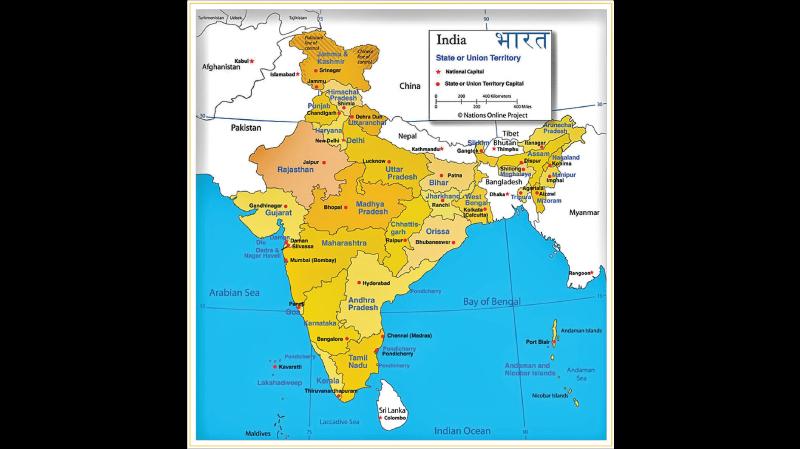
Being the home of one of the world’s oldest civilisations and great religions, India has been changing and reshaping itself producing new forms of culture and absorbing influences from developed countries.
It is the land where the Buddha lived, walked and preached, Adi Shankara taught his Advaita philosophy, Cholas built magnificent temples and Moghuls erected the Taj Mahal. It is a subcontinent full of spectacular carved temples, gleaming marble palaces and Mahals. India, today, is a dynamic state racing towards super power status in the 21st century. Morgan Stanley predicts that India will be the third largest economy in the world in 2027.
The boundaries of modern India had been fixed in less than 75 years. They are merely the latest in a 5,000-year sequence of redefining that has produced one of the most heterogenous societies in the world. Many first time visitors cannot see past the grinding poverty of some of the country’s most disadvantaged citizens.
Others expect a timeless ascetic wonderland and are indignant to find that materialism has its place here too. Still more people find themselves intimidated by what may seem initially an incomprehensible and bewildering country.
India, with over one billion people, has recreated itself as both a majority Hindu nation and the world’s largest secular democracy. Indians have endured tyranny in some form or the other for hundreds of years under foreign rule. First, it was under Muslim invaders and later, it came under colonial rule of European powers.
Strong and resilient democracy
You can imagine the joy of the people when they were freed from colonial rulers. India gradually emerged as a strong and resilient democracy. This can be regarded as one of the miracles in modern history. The sheer diversity would have made the odds seem insurmountable.
During the past 75 years, India witnessed 14 general elections, countless state elections and a dozen Prime Ministers taking office. During those hectic years, India achieved significant economic progress.
The growth acceleration started in the 1980s on an annual average of 6 percent. There were a few mini-revolutions which fuelled the growth of the economy. The IT (Information Technology) boom in the 1980s was followed by the automotive revolution that started with the local production of automobiles.
Meanwhile, many foreign companies set up their factories in India. In the early part of 2000, India achieved an amazing growth in telecommunications and digitisation. With the vast improvement of the financial sector, India has become the fifth largest economy in the world. Unfortunately, Sri Lanka failed to achieve a similar economic growth as it failed to capitalise on opportunities.
Economic achievement
One of the reasons for India’s economic achievement is the leadership provided by Prime Minister Narendra Modi who led the Bharatiya Janata Party (BJP) to victory in 2014. He clinched an election victory again in 2019. Political observers believe that he will win the 2024 general election hands down. Modi had a clear vision from the beginning of his career.
In his first Independence Day speech, he said he was the nation’s servant, not its master. His participative government has become the cornerstone of his administration. It is evident in his policies such as Clean Bharat, giving up free gas cylinders and going back to the nation’s cultural moorings.
Modi said that he is a ‘Sanyasi’ (ascetic) who will pack his bags and move on when the time comes. Even the former Indian President Abdhul Kalam’s simplicity became public when he left his presidential palace at the end of his tenure carrying all his belongings in a single suitcase. Earlier, he was the head of the Indian Space Research Organization (ISRO). During the demonetisation crisis, Modi said, “One must distinguish between policy and execution strategy. Demonetisation which reflects our policy is unequivocally clear, unwavering and categorical.”
Structural reforms
An important question is whether India’s rate of growth will stabilise or continue to grow further. Modi has indicated that he is determined to implement vital structural reforms. He is of the view that India cannot lag behind in the race to catch up with developed nations. The only way out is upgrading human resources, especially improving the quality of skilled labour. The Government has to spend more on research and development. At the same time, the Government has to boost trade and infrastructure facilities to encourage the private sector. The recent privatisation of the loss-making Air India is now making profits. The new owner of Air India (TATA) has placed an order for 500 aircraft including Boeing and airbuses.
A recent economic survey indicates that the slowdown of the Indian economy in 2020 and 2021 has already been reversed. The Indian stock market is moving ahead and more overseas funds are trickling into the 3.1 trillion equity market. According to Bloomberg News survey, the Indian stock market is ebbing fast. All the indications point to the fact that Modi is destined to raise India to greater heights in the near future.
The writer is a freelance journalist and Indologist based in Hyderabad, India.
